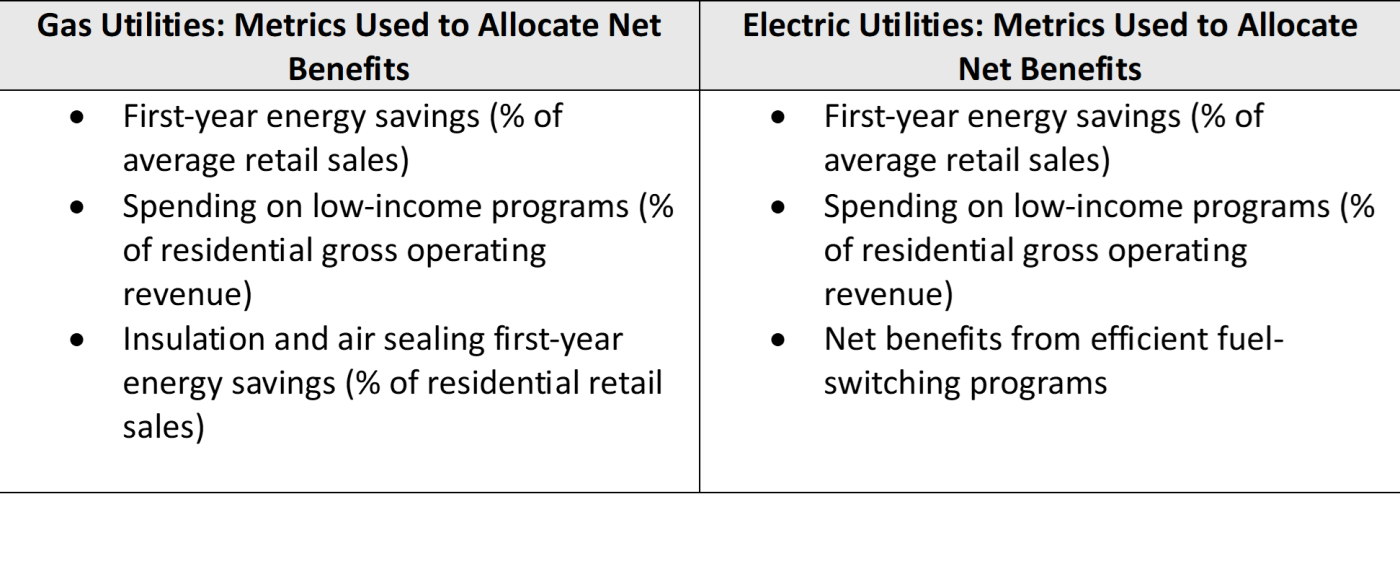On June 26, CEE, the Minnesota Department of Commerce, Division of Energy Resources (Department), and Fresh Energy filed a proposal that, if approved by the Minnesota Public Utilities Commission, would reshape the utility financial incentive for Energy Conservation and Optimization (ECO) programs.
Through ECO, Minnesota utilities provide energy conservation programs to their customers, including energy efficiency, efficient fuel-switching (EFS), and load management programs. Utilities must meet statutory requirements for their ECO programs, such as a minimum level of energy savings, but they can also earn a financial incentive if they meet or exceed certain metrics. The financial incentive motivates utilities to go above and beyond minimum requirements, driving innovative programming.
Currently, for purposes of calculating the financial incentive, a utility’s performance is measured using two metrics: the cost-effectiveness of the utility’s ECO portfolio and the amount of first-year energy savings generated. Utilities are motivated to prioritize these two metrics when designing their ECO portfolios, as the higher their cost-effectiveness and first-year energy savings, the larger their financial incentive.
Although cost-effectiveness and first-year energy savings continue to be essential components of ECO programming, the current incentive mechanism does not fully capture other important considerations. CEE, the Department, and Fresh Energy’s proposal incorporates additional metrics into the financial incentive mechanism, namely low-income spending, energy savings from insulation and air-sealing measures for gas utilities, and net benefits from efficient fuel-switching (EFS) for electric utilities. These new metrics better align the ECO financial incentive with state policy goals and recent evolutions in the ECO framework following the passage of the 2021 ECO Act.
Overview of the proposed incentive mechanism
The current ECO incentive mechanism in place for the 2024–2026 Triennial awards utilities with a percentage of the net benefits (a measurement of cost-effectiveness) generated by their ECO portfolios. The amount of net benefits awarded is based on the amount of first-year savings produced by the ECO portfolio. An example of energy savings under ECO is the energy saved by replacing a standard air conditioning unit with an air source heat pump.
The mechanism proposed for the 2027–2029 Triennial by CEE, the Department, and Fresh Energy would continue to reward utilities with a share of net benefits, but the percentage of net benefits would be determined by multiple metrics in addition to first-year energy savings. The following table provides an overview of the metrics included in the proposal.

Low-income spending
Low-income ECO programs provide essential benefits to low-income customers, reducing energy bills, improving comfort, and in some cases, making homes healthier for customers who typically face significantly higher energy burdens, meaning they spend a disproportionate percentage of their income on energy costs. Despite the importance of these programs, they are typically not cost-effective as they tend to be more expensive to implement and are therefore not emphasized under the current incentive mechanism.
The proposed mechanism establishes a new metric for both gas and electric utilities that awards a portion of net benefits based on a utility’s spending on low-income programs. A spending metric encourages utilities to invest in measures like pre-weatherization, which do not generate direct energy savings but are essential for enabling effective low-income programming.
Insulation and air sealing (gas utilities)
Insulation and air-sealing measures produce long-term, fuel-neutral energy savings, increasing comfort for customers and lowering energy costs. Insulation and air-sealing measures are also a precursor to affordable efficient fuel-switching in buildings, as weatherized homes have smaller size requirements for heat pumps and enable heat pumps to meet more of the annual space heating load.
Due to the high upfront costs of insulation and air-sealing measures, they are often harder to implement. As a result, these measures are typically not prioritized, and gas utilities have allocated only a small portion of their ECO spending to them. Instead, a larger share of spending goes toward rebates for high-efficiency gas equipment.
To better incentivize insulation and air sealing in ECO programming, the proposed 2027–2029 mechanism includes a metric for gas utilities that awards a portion of net benefits based on the amount of first-year energy savings generated through insulation and air sealing measures.
Efficient fuel-switching (electric utilities)
Under changes made to the ECO framework by the 2021 ECO Act, utilities are now allowed to include EFS measures in their ECO portfolios, provided they result in a net reduction in the amount of source energy consumed and statewide greenhouse gas emissions and are cost-effective. EFS is an important tool for fulfilling Minnesota’s commitment to achieving net zero greenhouse gas emissions by 2050 and 100% carbon-free electricity by the end of 2040. An example of an EFS measure includes switching customers who heat with natural gas or propane to an air source heat pump (ASHP).
Under the current incentive mechanism, electric utilities cannot count savings and net benefits from EFS programs when calculating their financial incentives. The proposed 2027–2029 incentive mechanism includes an EFS incentive for electric utilities based on the net benefits generated by EFS programs and the Ratepayer Impact Measure test benefit–cost ratio of these programs, which captures whether they put a downward pressure on rates for all customers.
Next steps
CEE, the Department, and Fresh Energy filed the proposal on June 26 in Docket Number E,G999/CI-08-133 after several months of research and stakeholder engagement. The proposal will undergo a comment period and must be approved by the PUC. With the 2027–2029 ECO Triennial Plans due in June 2026, CEE hopes the financial incentive mechanism will be approved by the end of 2025 to give utilities time to adjust their plans to the new metrics.
